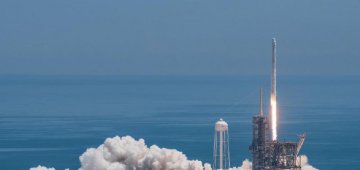LOS ANGELES, March 8 (Xinhua) -- After a five-day mission at the International Space Station (ISS), American spacecraft Crew Dragon parachuted to a splashdown in the Atlantic Ocean off Florida's eastern shore on Friday, completing an end-to-end flight test to the ISS and back to earth.
"It's been almost 50 years since we've landed a spacecraft that was designed for humans in the Atlantic Ocean. Last one was Apollo 9 on March 13, 1969," the National Aeronautics and Space Administration (NASA) tweeted.
The spacecraft of U.S. private spaceflight company SpaceX returned to earth with a splash in the Atlantic Ocean off Florida's eastern shore at 8:45 a.m. Eastern Time (1345 GMT). SpaceX's "Go Searcher" recovery ship, staged in the ocean, approached the Crew Dragon and will use a crane to lift the spacecraft out of the ocean, according to NASA.
"Today's successful splashdown of the Demo-1 Crew Dragon capsule after its mission to the ISS marked another milestone in a new era of human spaceflight," NASA Administrator Jim Bridenstine tweeted.
The NASA Commercial Crew Program is one step closer to launching American astronauts on American rockets from American soil, he said.
The spacecraft undocked from the ISS at 2:32 a.m. Eastern Time (0732 GMT). It slowly maneuvered away from the ISS into an orbital track to return to Earth, according to NASA.
Before the undocking, ISS crew members closed and locked the Dragon's hatch on Thursday afternoon.
Crew Dragon, designed to fly astronauts to the ISS, was rocketed into orbit Saturday morning for its maiden unmanned flight. It successfully docked with the space station on Sunday, and remained docked for five days before departing on Friday.
It was the first autonomous docking of any U.S. spacecraft to the ISS. The Crew Dragon used the station's new international docking adapter for the first time since astronauts installed it during a spacewalk in August 2016.
The first commercial crew vehicle is bringing back to Earth more than 330 pounds (about 136 kg) of science gear, crew supplies and station hardware, according to NASA. It delivered almost 450 pounds (about 204 kg) of materials to resupply the station crew Saturday.
The capsule carried to the ISS a test dummy called Ripley, named after the heroine from the "Alien" movies, which was outfitted with sensors to provide data about potential effects on future astronauts who will travel in the Crew Dragon.
After the spacecraft is safely home, an immense amount of work will commence to analyze all the data gathered during this test flight. A series of reviews will be carried out before another critical In-Flight Abort test scheduled for April and the first crewed Crew Dragon mission planned for this July.
The demonstration mission, called Demo-1, is the first flight test of a space system designed for humans built and operated by a U.S. commercial company through a public-private partnership.
The mission also marks a significant step forward to the resumption of launching astronauts to the space station on a U.S.-built spacecraft from U.S. soil since 2011.




















Latest comments